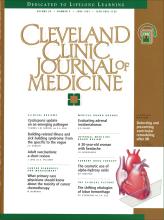Table of Contents
Medical Grand Rounds
- Evaluating adrenal incidentalomas
Adrenal incidentalomas are detected on approximately 1% to 2% of all abdominal CT scans. The question is, how clinically significant are they?
Internal Medicine Board Review
- A 30-year-old woman with headache
On the basis of the clinical picture and laboratory data, what is the most likely diagnosis?
Clinical Review
- Cyclospora: update on an emerging pathogen
Cyclospora cayetanensis, an emerging pathogen with worldwide distribution, causes diarrhea in both immunocompetent and HIV-infected patients, and was responsible for a 1996 outbreak in the United States.
- Building-related illness and sick building syndrome: from the specific to the vague
Building-related illness, in which an identifiable factor causes a specific illness, is less common than sick building syndrome, in which there is no identifiable cause for nonspecific symptoms.
- Adult vaccinations: a short review
Recommended use of vaccines against pneumococcal pneumonia, influenza, hepatitis A and B, varicella, measles, mumps, rubella, tetanus, and diphtheria.
- Detecting and preventing ventricular remodeling after MI
Infarct expansion after an MI carries a poor prognosis. Thrombolysis prevents early left ventricular dilatation by attenuating infarct expansion. A full-color illustration compares the effects of early reperfusion, late reperfusion, and no reperfusion.
Current Drug Therapy
- Cosmetic use of alpha-hydroxy acids
Alpha-hydroxy acids exfoliate dead skin cells, moisturize the skin, and possibly rejuvenate skin damaged by photoaging.
The Clinical Picture
- The shifting etiologies of lobar hemorrhage
Better treatment of hypertension is changing the type of intracranial hemorrhages physicians most often see.
Medical Grand Rounds
- What primary care physicians should know about the toxicityof cancer chemotherapy
Although symptomatic side effects of chemotherapy reduce a patient’s quality of life, organ-system effects are potentially more serious.



